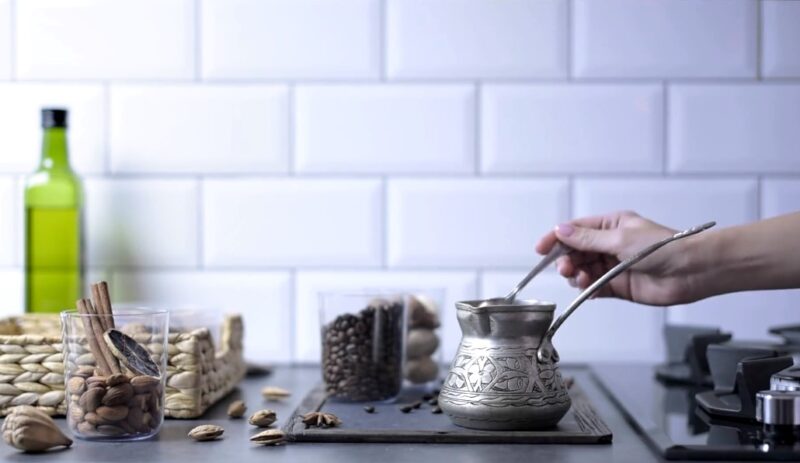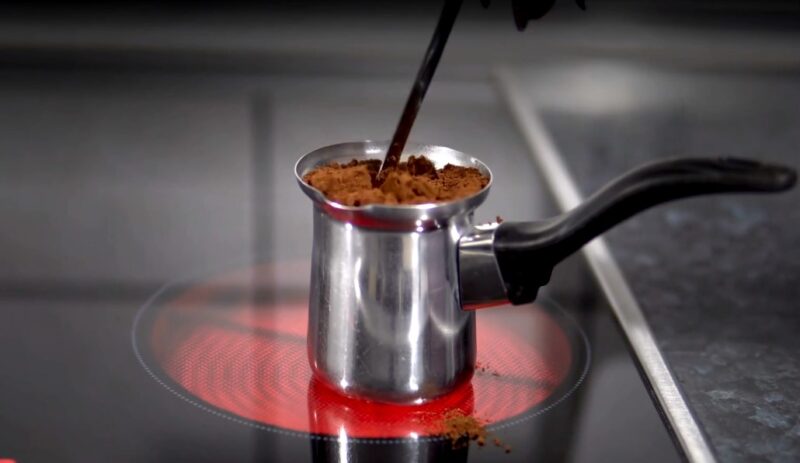Turkish coffee is a time-honored tradition that dates back centuries, with its roots deeply embedded in the rich cultural heritage of Turkey. This delightful beverage offers a unique and aromatic experience, cherished by coffee enthusiasts around the world.
We will take you on a journey to discover the origins of Turkish coffee, its global popularity, and provide a detailed step-by-step process to make this cherished brew in the comfort of your home. So, let’s embark on this flavorful adventure! ☕
Step-by-Step Guide

🛠️ Ingredients:
- Freshly ground Turkish coffee beans
- Cold water
- Sugar (optional)
- Cardamom (optional, for added flavor)
🍴 Utensils Needed:
- Turkish coffee pot (cezve/ibrik)
- Coffee grinder (for grinding beans)
- Measuring spoon (to ensure precise ratios)
- Small serving cups (traditionally small and handle-less)

📃 Step 1: Measure the Coffee and Water Measure one heaping tablespoon of freshly ground Turkish coffee per serving cup and add it to the Turkish coffee pot. Pour an equal amount of cold water into the pot for each cup of coffee.
📃 Step 2: Optional: Add Sugar and Cardamom If you prefer your Turkish coffee sweet, you can add sugar to taste before placing the pot on the stove. For a touch of aromatic delight, consider adding a pinch of ground cardamom as well.
📃 Step 3: Heat and Stir Place the Turkish coffee pot on low heat and stir gently to mix the ingredients. Avoid rushing this process to allow the flavors to meld perfectly. The slower the heat, the better the taste.
📃 Step 4: Create the “Froth” As the coffee heats, you will notice a frothy layer forming on top. This is a crucial element of Turkish coffee, and you should keep a close eye on it.
📃 Step 5: Pour Slowly Once the froth forms, carefully pour the coffee into the serving cups, ensuring that each cup receives an equal amount of froth.
📃 Step 6: Let it Settle Allow the coffee to settle for a moment, letting the grounds sink to the bottom. This step ensures you’ll enjoy a smooth, rich cup without the sediment.
📃 Step 7: Enjoy! Turkish coffee is meant to be savored slowly, relishing its unique flavors and aromas. Take a moment to enjoy this delightful brew, and immerse yourself in its cultural heritage.

🚩 Alternative Solutions for Dietary Restrictions and Limited Utensils 🚩
For those with dietary restrictions, Turkish coffee can be easily adapted to suit individual preferences. Here are some alternative solutions to cater to different dietary needs:
- Sugar-Free Turkish Coffee: If you prefer your coffee without added sugar, simply omit it from the recipe. Turkish coffee is versatile and can be enjoyed with or without sweeteners. The slow brewing process brings out the natural sweetness of the coffee beans, ensuring a satisfying cup even without sugar.
- Customized Sweeteners: For individuals who are looking for a sweetened option but want to avoid regular sugar, there are various alternative sweeteners available in the market. Options like honey, agave syrup, or stevia can be used as substitutes. Keep in mind that the sweetness level can be adjusted to your liking, ensuring a personalized experience.
- Cardamom-Free Option: While cardamom adds a unique and aromatic flavor to Turkish coffee, some individuals may not enjoy its taste or have allergies to certain spices. In such cases, it’s entirely acceptable to skip the cardamom or experiment with other spices that suit your taste preferences, such as a touch of cinnamon or nutmeg.
As for limited utensils, not having a traditional Turkish coffee pot should not hinder you from enjoying this delightful brew. Here are alternative methods to achieve a similar result:
- Small Saucepan: If you don’t have a Turkish coffee pot (cezve/ibrik), a small saucepan can be used as a substitute. Choose a saucepan that can comfortably hold the desired number of servings. It’s essential to maintain a low heat setting and closely monitor the brewing process to prevent overheating or boiling over.
- Heat-Resistant Bowl: In the absence of a small saucepan, a heat-resistant bowl can also serve as a makeshift coffee pot. Make sure the bowl is suitable for stovetop use and that it can withstand the heat. Similar to the saucepan method, keep the heat low and be attentive during the brewing process.
- Traditional Coffee Pot Alternatives: If you have a traditional coffee maker, you can attempt to recreate the Turkish coffee experience by using finely ground coffee and modifying the brewing process. While the result won’t be exactly the same as Turkish coffee, it can still offer a rich and flavorful cup.
🏰 Origins 🏰
The fascinating history of Turkish coffee stretches back to the vibrant era of the Ottoman Empire. It was during the 16th century that coffee made its grand entrance into the lands of modern-day Turkey, igniting a cultural phenomenon that would endure for centuries to come.
A Brief Historical Timeline:
| Year | Significant Event |
|---|---|
| 1555 | Arrival of Coffee in Istanbul: The first coffeehouses open in Istanbul, introducing the beverage to Ottoman society. Coffeehouses quickly become centers of socialization, discussion, and entertainment. |
| 17th Century | Coffee Spreads Beyond Borders: The popularity of Turkish coffee expands beyond the Ottoman Empire, reaching the neighboring regions of Europe, the Balkans, and the Middle East. |
| 17th Century | “Kahvecibaşı”: The title “Kahvecibaşı” is established, designating the chief coffee maker in the Ottoman palace. This position highlights the significance of coffee in the royal court and society. |
| 19th Century | Turkish Coffee in Europe: The charm of Turkish coffee captivates European travelers and dignitaries, leading to the opening of Turkish-style coffeehouses in major European cities. |
| 20th Century | Coffeehouses as Cultural Hubs: Turkish coffeehouses continue to thrive as essential centers for intellectual discussions, chess games, and cultural gatherings throughout the 20th century. |
| 2013 | UNESCO Intangible Cultural Heritage: Turkish coffee is inscribed as an Intangible Cultural Heritage by UNESCO, recognizing its cultural significance and its role in fostering community bonds. |
🌎Around the World🌎

As a testament to its widespread appeal, Turkish coffee has transcended borders and can now be found enjoyed by coffee enthusiasts worldwide. Let’s take a look at some fascinating statistics on the consumption of Turkish coffee in the top 10 countries:
| Rank | Country | Average Cups Consumed Per Day |
|---|---|---|
| 1 | Turkey | 5 cups |
| 2 | Greece | 4 cups |
| 3 | Bosnia and Herzegovina | 3 cups |
| 4 | Lebanon | 2 cups |
| 5 | Jordan | 2 cups |
| 6 | Cyprus | 1.5 cups |
| 7 | Saudi Arabia | 1 cup |
| 8 | Iraq | 1 cup |
| 9 | Armenia | 1 cup |
| 10 | Israel | 0.5 cups |
FAQs

How long does it take to brew Turkish coffee?
The brewing process for Turkish coffee is relatively quick, usually taking around 5 minutes. The key is to maintain low heat for the best results.
Can I make Turkish coffee in a traditional coffee maker?
While it won’t be the exact same, you can try making a Turkish coffee-inspired brew using a traditional coffee maker. Use finely ground coffee and adjust the brewing process for a closer experience.
What makes coffeehouses in Turkey unique?
Turkish coffeehouses, known as “kahvehane,” are unique social hubs where people gather for intellectual discussions, games, and cultural exchanges, making them an integral part of Turkish culture.
Is Turkish coffee traditionally served in specific cups?
Yes, Turkish coffee is traditionally served in small, handle-less cups called “fincan.” These cups are specially designed to complement the unique experience of savoring Turkish coffee.
☕ Conclusion ☕
With its centuries-old tradition and global popularity, Turkish coffee remains an enchanting cultural delight that transcends borders and brings people together. By following our easy-to-follow guide, you can now embark on your own Turkish coffee-making journey and enjoy the rich and aromatic flavors of this beloved beverage. So, get your Turkish coffee pot ready, grind those beans, and immerse yourself in the art of Turkish coffee brewing! Happy sipping!
Hi, I’m Dean Terry, and cakes are my life! I’ve spent over a decade perfecting the art of creating cakes that not only look incredible but taste unforgettable. What started as a hobby in my own kitchen quickly turned into a full-on passion, and now I get to craft one-of-a-kind cakes for weddings, birthdays, and big celebrations.
For me, it’s all about the details—whether I’m designing an elegant buttercream finish or a crazy multi-tiered cake with wild designs, I make sure each cake tells a story. I’m always experimenting with flavors and techniques, because why settle for the ordinary when you can create something extraordinary?
When I’m not up to my elbows in frosting, you’ll probably find me teaching others how to bake or dreaming up my next big cake challenge. If there’s one thing I believe, it’s that every great celebration deserves a cake that’s as special as the moment itself!







